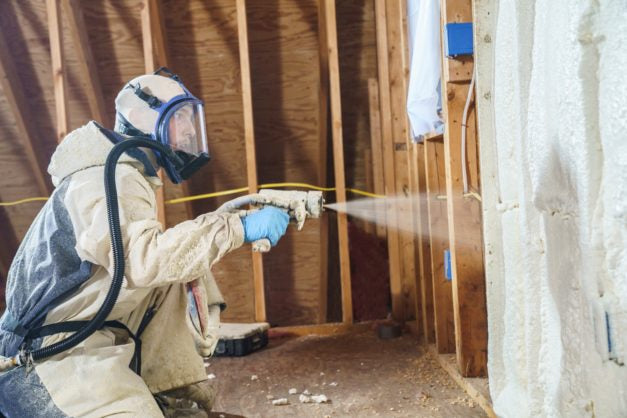Know: Is it Safe to Be in The House During Spray Foam Insulation?
Many homeowners wonder if it's safe during spray foam insulation. They ask, "Can I stay in my home while it's being installed?" VB Insulation's team offers the info you need to choose wisely.

Key Takeaways
- Spray foam insulation off-gassing can affect indoor air quality for up to 48 hours after installation.
- Isocyanates used in spray foam can pose respiratory and skin irritation risks, especially for those with pre-existing conditions.
- Proper ventilation and protective equipment are crucial for both installers and homeowners during and after the application process.
- Staying out of the house for 24-72 hours is recommended to allow for full curing and off-gassing of the spray foam.
- Using an air purifier can help eliminate lingering odors and improve indoor air quality after spray foam insulation is installed.
Understanding Spray Foam Insulation
Vega Bond V600 Insulation Kit is a well-loved choice in many construction projects. Its flexibility and efficiency are behind its widespread use in homes and businesses. At VB Insulation, we know a lot about spray foam. We are happy to give you a detailed look at the various kinds available.
Types of Spray Foam Insulation
There are two notable types of spray foam insulation: open-cell and closed-cell. Each has features that make it perfect for various uses.
Open-Cell Spray Foam Insulation
Open-cell spray foam is softer and less dense. It permits airflow, which limits its use as a vapor barrier. Yet, its design fights moisture, offering solid insulation without the worry of dampness. It boasts a lower R-value than closed-cell foam but can be more economical for some projects.
Closed-Cell Spray Foam Insulation
Closed-cell spray foam is dense and rigid. It stands up as a strong vapor barrier. With a higher R-value, it excels at insulation and also strengthens the structure. For places where stopping moisture and top-notch insulation are key, closed-cell foam is often the top option.
People have been using spray foam since the 1970s and 1980s. It was once seen as a fast and cheap insulation fix. However, some early troubles, like poor application leading to shrinkage and cracks, showed the need for proper installation.

Safety Concerns and Precautions
Spray foam insulation involves chemicals that can be risky to our health. These chemicals, like isocyanates, are highly reactive. They can cause skin, eye, and breathing problems.
Chemicals Used in Spray Foam Insulation
Spray foam contains mixtures of isocyanates, polyols, and blowing agents. Isocyanates allow the foam to expand and harden. They can irritate and can be quite dangerous if not handled properly.
Isocyanates and Their Risks
When applying spray foam, people can breathe in these chemicals. This can lead to lung issues and asthma. Contact with the skin can cause irritation and allergic reactions. Protecting against these risks is vital for everyone's safety.
Protective Equipment for Installers
Those working with spray foam need the right protective gear. This includes coveralls, gloves, goggles, and a mask with the right filters. Good air circulation and checking air quality are also very important.
Knowing about the dangers and how to protect against them is crucial for safe installation. This knowledge helps both homeowners and workers stay safe.

Is it Safe to Be in The House During Spray Foam Insulation?
Safety is a big concern when using spray foam insulation, especially for those living in the house. The specific type of foam used can affect how long you should stay out.
Open-Cell Foam Insulation Curing Time
When using open-cell foam, you should wait at least a full day outside your house. This lets the foam fully cure, and any smell disappears. It takes about 24 hours for the foam to be completely set.
Closed-Cell Foam Insulation Curing Time
Closed-cell foam insulation requires you to stay away for 48 hours. This longer time is needed for the foam to cure and fully stop releasing gases. It takes around 48 hours for it to finish off-gassing.
Ventilation Requirements
No matter the foam type, good airflow is critical. Proper ventilation reduces the risk of breathing in harmful chemicals, which is key to keeping the air safe for everyone inside.
Potential Health Risks and Precautions
Spray foam insulation is becoming more popular, but it comes with risks. It contains isocyanates, polyols, and other chemicals that can affect indoor air and health.
Off-gassing and Indoor Air Quality
As spray foam cures, it emits harmful chemicals, including benzene, chlorine compounds, and formaldehyde. These can lower air quality and harm people and pets. Good ventilation and monitoring can help reduce these risks.
Respiratory Concerns
Diisocyanates in spray foam, like MDI, can be dangerous. They may cause asthma, lung damage, and, in severe cases, death. People with asthma are especially at risk.
Skin and Eye Irritation
Spray foam can also irritate the skin and eyes, causing discomfort. Wearing proper protective equipment while working with it helps keep you safe.
We at VB Insulation care a lot about safety. Our teams are trained to use spray foam properly. They wear the right protective gear and watch air quality closely. With safety measures in place, enjoying the benefits of spray foam while reducing health risks is possible.
Post-Installation Safety Measures
After installing spray foam insulation, safety is key for homeowners, their families, and pets. VB Insulation, a top provider, has tips to get rid of the spray foam smell and boost the air quality.
Removing Lingering Odors
Sometimes, after spray foam is installed, you might smell something odd. VB Insulation suggests using an air purifier to get rid of the smell. Also, opening windows and turning on fans can clear the smell faster.
Air Purification Strategies
VB Insulation receives high-efficiency air purifiers to ensure clean air in your home. These purifiers can remove harmful particles from the air, making your home safer.
Following these steps ensures your home stays safe after using spray foam. VB Insulation helps ensure your home stays comfortable and your indoor air remains good.
Conclusion
After collecting info from many sources, we've learned a lot about keeping safe with spray foam insulation. This type of insulation is great for saving energy. But it's really important to use it safely, making sure to think about how it dries and the air you're in. This will keep everyone, including pets, safe when it's being in and long after.
Knowing about the chemicals it uses, when it stops giving off smells, and any risks to health helps everyone make smart choices. VB Insulation, a trusted company, puts a big focus on keeping you safe from start to finish.
With the right steps, spray foam insulation becomes a good choice for homes. By following the rules for installing it, keeping the air fresh, and cutting down on smells, enjoying its benefits is easy. This is all about looking out for your family's safety.
FAQ
Is it safe to be in the house during spray foam insulation installation?
Experts say homeowners, children, and pets can be inside the house during spray foam installation from VB Insulation. It's because the insulation doesn't contain harmful gases, and any smell will disappear within a few hours.
What are the different types of spray foam insulation?
As explained by the second source, there are two main types of spray foam insulation: open-cell and closed-cell. Open-cell foam is softer and less dense, while closed-cell foam is more rigid and insulates better. Open-cell foam is better where there's condensation. Closed-cell foam, however, has a higher R-value and acts as a vapor barrier.
What are the potential health risks associated with spray foam insulation?
The third and fourth sources warn about the possible health risks of spray foam insulation. These include isocyanates, which can irritate the skin, eyes, and lungs, leading to asthma. Isocyanates can also be dangerous during a fire, producing toxic fumes and high heat.
How long should homeowners stay out of the house after spray foam insulation installation?
The third source says the time to stay out after installation depends on the foam type. For open-cell foam, wait 24 hours. Closed-cell foam requires a longer wait of 48 hours. This time allows for proper curing and chemical off-gassing.
How can homeowners remove lingering odors from spray foam insulation after installation?
To get rid of spray foam smells, the third source suggests using an air purifier. It helps to remove any leftover odors. Opening windows and using fans at high speed will also help by increasing airflow.




